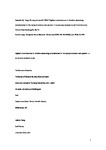Vigilant attentiveness in families observing deterioration in the dying intensive care patient: A secondary analysis study.
| dc.contributor.author | Coombs, M | en |
| dc.contributor.author | Tang, J | en |
| dc.contributor.author | Long-Sutehall, T | en |
| dc.date.accessioned | 2018-12-16T13:08:23Z | |
| dc.date.available | 2018-12-16T13:08:23Z | |
| dc.date.issued | 2016-04 | en |
| dc.identifier.uri | http://hdl.handle.net/10026.1/13049 | |
| dc.description.abstract |
BACKGROUND: Family support in intensive care is often focussed on what information is communicated to families. This is particularly important during treatment withdrawal and end of life care. However, this positions families as passive receivers of information. Less is known about what bereaved family members actually observe at end of life and how this is interpreted. AIM: Secondary analysis study was conducted in order to explore the concept of vigilant attentiveness in family members of adult patients dying in intensive care. METHOD: Secondary analysis of eight interviews sorted from two primary data sets containing 19 interviews with 25 bereaved family members from two intensive care units in England was undertaken. Directed content analysis techniques were adopted. FINDINGS: Families are observant for physiological deterioration by watching for changes in cardiac monitors as well as paying attention to how their relative looks and sounds. Changes in treatment/interventions were also perceived to indicate deterioration. CONCLUSION: Families are vigilant and attentive to deterioration, implying that families are active participants in information gathering. By clarifying what families notice, or do not notice during the dying trajectory in ICU, health care professionals can tailor information, helping to prepare families for the death of their relative. | en |
| dc.format.extent | 65 - 71 | en |
| dc.language | eng | en |
| dc.language.iso | eng | en |
| dc.rights | Attribution-NonCommercial-NoDerivatives 4.0 International | en |
| dc.rights | Attribution-NonCommercial-NoDerivatives 4.0 International | en |
| dc.rights | Attribution-NonCommercial-NoDerivatives 4.0 International | en |
| dc.rights | Attribution-NonCommercial-NoDerivatives 4.0 International | en |
| dc.rights | Attribution-NonCommercial-NoDerivatives 4.0 International | en |
| dc.rights | Attribution-NonCommercial-NoDerivatives 4.0 International | en |
| dc.rights.uri | http://creativecommons.org/licenses/by-nc-nd/4.0/ | en |
| dc.rights.uri | http://creativecommons.org/licenses/by-nc-nd/4.0/ | en |
| dc.rights.uri | http://creativecommons.org/licenses/by-nc-nd/4.0/ | en |
| dc.rights.uri | http://creativecommons.org/licenses/by-nc-nd/4.0/ | en |
| dc.rights.uri | http://creativecommons.org/licenses/by-nc-nd/4.0/ | en |
| dc.rights.uri | http://creativecommons.org/licenses/by-nc-nd/4.0/ | en |
| dc.subject | Death and dying | en |
| dc.subject | End of life care | en |
| dc.subject | Families | en |
| dc.subject | Intensive care | en |
| dc.subject | Critical Care | en |
| dc.subject | England | en |
| dc.subject | Family | en |
| dc.subject | Female | en |
| dc.subject | Humans | en |
| dc.subject | Male | en |
| dc.subject | Professional-Family Relations | en |
| dc.subject | Terminal Care | en |
| dc.title | Vigilant attentiveness in families observing deterioration in the dying intensive care patient: A secondary analysis study. | en |
| dc.type | Journal Article | |
| plymouth.author-url | https://www.ncbi.nlm.nih.gov/pubmed/26875444 | en |
| plymouth.volume | 33 | en |
| plymouth.publication-status | Published | en |
| plymouth.journal | Intensive Crit Care Nurs | en |
| dc.identifier.doi | 10.1016/j.iccn.2015.12.002 | en |
| plymouth.organisational-group | /Plymouth | |
| plymouth.organisational-group | /Plymouth/REF 2021 Researchers by UoA | |
| plymouth.organisational-group | /Plymouth/REF 2021 Researchers by UoA/UoA03 Allied Health Professions, Dentistry, Nursing and Pharmacy | |
| dc.publisher.place | Netherlands | en |
| dc.identifier.eissn | 1532-4036 | en |
| dc.rights.embargoperiod | Not known | en |
| rioxxterms.versionofrecord | 10.1016/j.iccn.2015.12.002 | en |
| rioxxterms.licenseref.uri | http://creativecommons.org/licenses/by-nc-nd/4.0/ | en |
| rioxxterms.type | Journal Article/Review | en |



